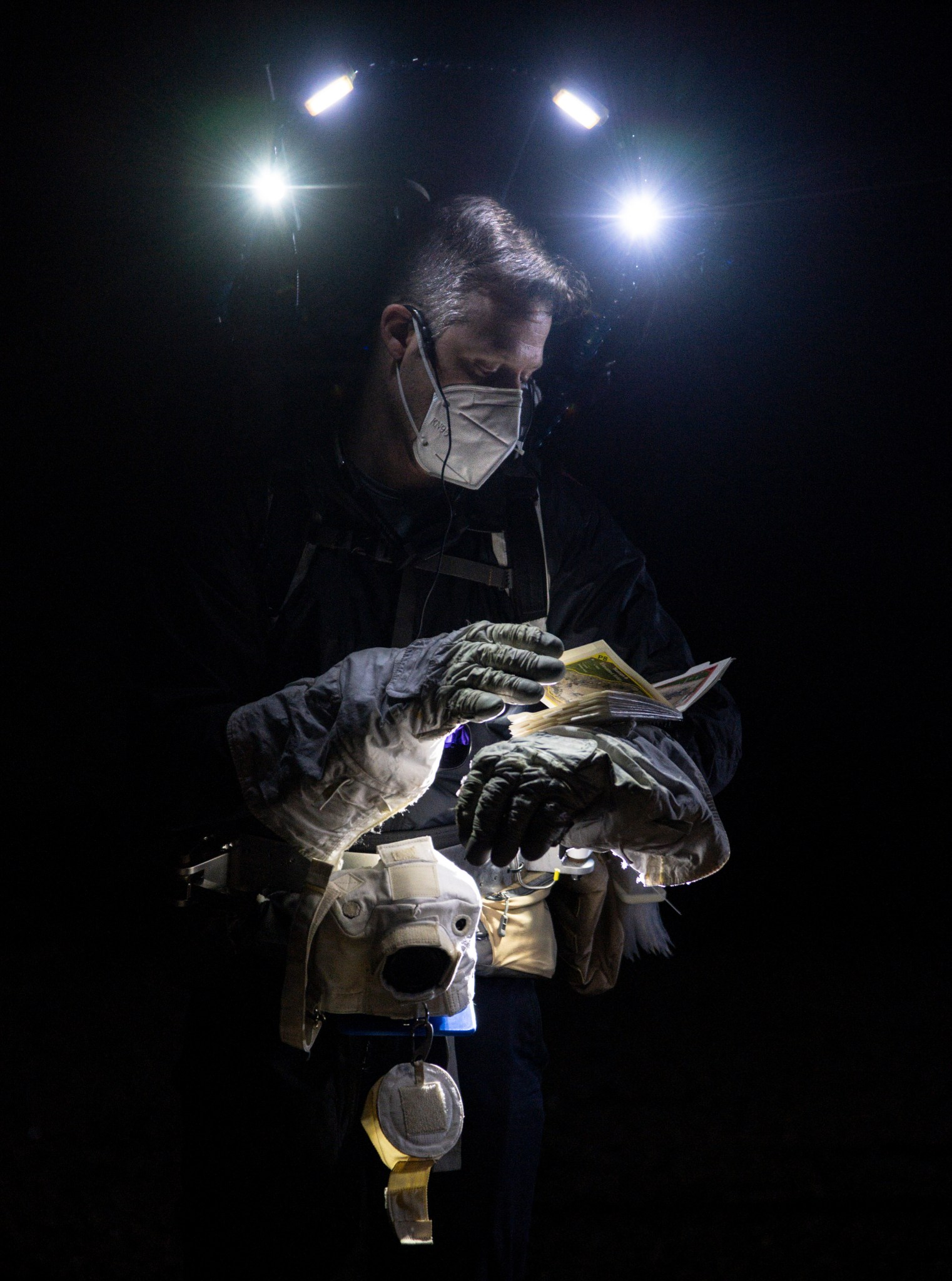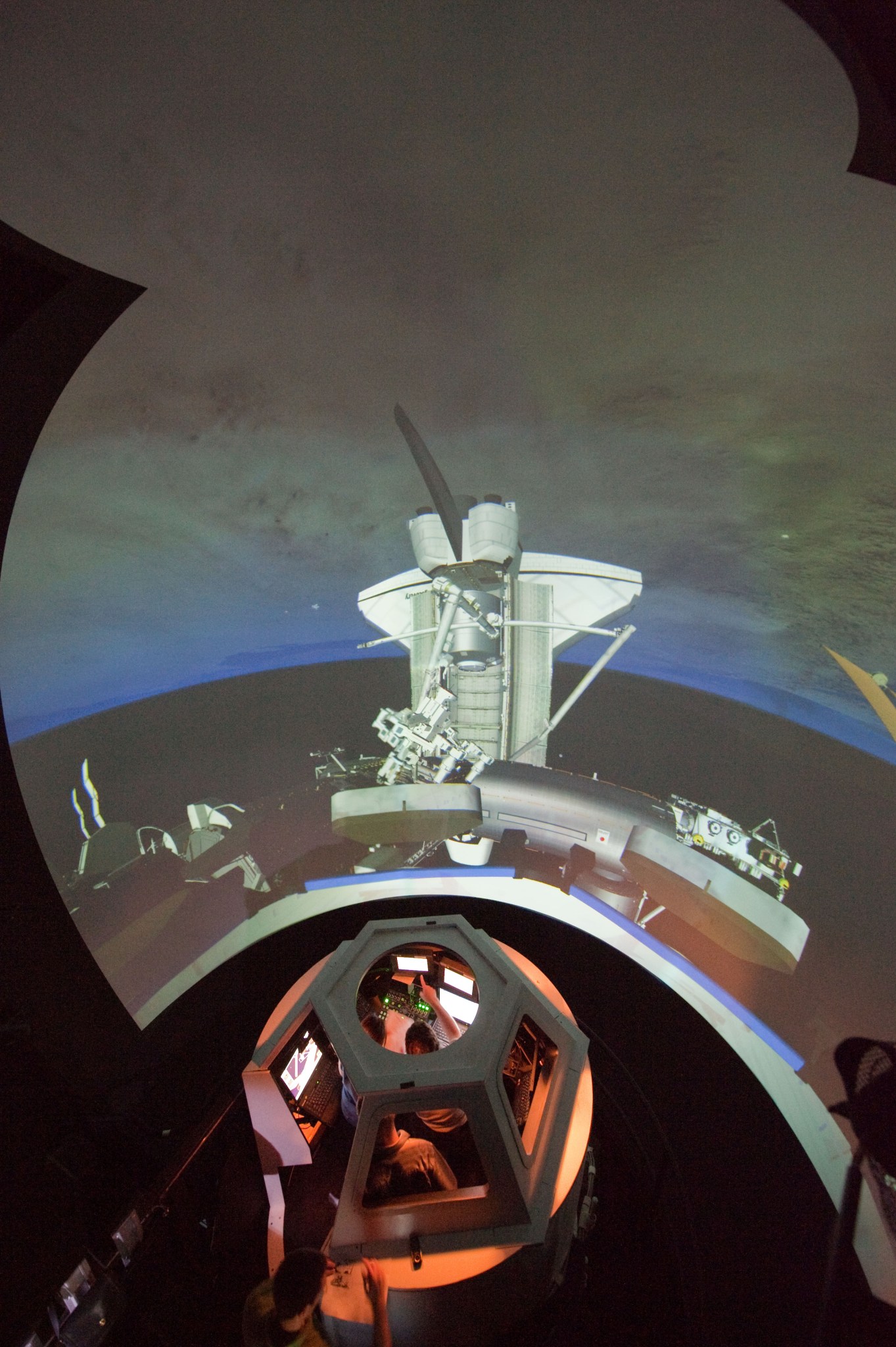Simulation & Modeling

Introduction
Modeling and simulation are critical for human spaceflight as they enable in-depth analysis, assessment and verification of spacecraft and mission performance, ensuring the safety, efficiency, and success of complex space endeavors before they are executed in the actual environment. NASA Johnson Space Center (JSC) possesses a wide range of modeling and simulation capabilities, including: integrated simulations of missions, simulation architecture for mission training, a range of simulation environments, virtual reality training for astronauts, power system verification, electromagnetic analysis, communication systems, computational electromagnetics, thermal analysis, coupled loads analysis, dynamic systems testing, and specialized areas like decompression sickness research and management. JSC experts provide capabilities in developing high-fidelity, real-time, human-in-the-loop engineering simulations with math models, scene generation and realistic control station mockups. Expertise is available in software development, including flight and ground systems, real-time, mission critical, embedded software, software integration and hardware-in-the-loop testing. JSC also provides computer graphics and model development for engineering visualization as well as state-of-the-art facilities for testing advanced simulation environments, allowing integration of multiple models into a single simulation. We invite our partners to leverage our capabilities for your own human spaceflight space endeavors.
Integrated Mission Simulation
Trick Simulation Environment
Overview | Trick is a powerful simulation development framework that enables users to build applications for all phases of space vehicle development. Trick expedites the creation of simulations for early vehicle design, performance evaluation, flight software development, flight vehicle dynamic load analysis, and virtual/hardware in the loop training. It provides a common set of simulation capabilities that allows users to concentrate on their domain specific models, rather than simulation-specific functions like job ordering, input file processing, or data recording.
Details |
- Trick Generic Simulation Toolkit for rapid development of high-fidelity simulations
- Modular, reusable simulation packages to model the orbital environment (JEOD), multi-body dynamics (MBDYN), fluid dynamics (GUNNS), robotics (hydra), GN&C (Valkyrie), input devices (IDF), and displays & controls (DCAPP – ready to use applications)
- Six-Degrees-of-Freedom simulations of single- and multiple-vehicle missions for various flight phases
- User defined graphical user interfaces
Distributed Simulation
Overview | TrickHLA is a Trick-based software package that supports the Institute of Electrical & Electronic Engineers (IEEE) 1516-2010 HLA distributed simulation standard and the SpaceFOM.
Details | The TrickHLA software supports the Institute of Electrical & Electronic Engineers (IEEE) 1516-2010 High Level Architecture (HLA) simulation interoperability standard for the Trick Simulation Environment. The TrickHLA software abstracts away the details of using HLA, allowing the user to concentrate on the simulation and not worry about having to be an HLA distributed simulation expert. The TrickHLA software is data driven and provides a simple Application Programming Interface (API) making it relatively easy to take an existing Trick simulation and make it a HLA distributed simulation. TrickHLA also supports the Simulation Interoperability Standards Organization (SISO) Space Reference Federation Object Model (SISO-STD-018-2020) (SpaceFOM).
Integrated Graphics Operations and Analysis Laboratory (IGOAL)
Overview | The Integrated Graphics Operations and Analysis Laboratory (IGOAL) provides computer graphics services for organizations throughout NASA and other institutions. These services include highly realistic visualizations of space systems and conceptual design concepts; custom graphics programming for simulations, visualizations, and education and outreach; and 3D graphics model creation, reduction, verification, and validation.
Details |
Computer graphics services
- 3-D engineering visualization, modeling, and graphics custom software development
- Animated Graphics for Engineering Analysis (AGEA)
- Mobile applications for phones and tablets
- SATERN-style training modules (NASA’s internal training platform)
- IGOAL software programming supports many platforms including iOS, Android, Windows, Linux, and the web
- IGOAL graphics models can be output in many popular formats including FBX, Blender, AutoCAD, OBJ, and Inventor
- IGOAL software products include Space Station Research Explorer (mobile devices on iTunes and Google Play), Visual ISS Communication tool, AGEA, EMU Explorer, and Counter Measure Systems Explorer
JSC Engineering Orbital Dynamics (JEOD)
Overview | JSC Engineering Orbital Dynamics (JEOD) is a software package that provides Trick-based simulation with space environment and spacecraft dynamics models.
Details | The JEOD Software Package is a simulation tool designed to work with NASA Trick Simulation Environment that provides vehicle trajectory generation by the solution of a set of numerical dynamical models. These models are subdivided into four categories:1. Environment models representing the conditions surrounding the vehicle2. Dynamics models for integrating the equations of motion3. Interaction models representing vehicle interactions with the environment4. A set of mathematical and orbital dynamics Utility models JEOD is designed to simulate spacecraft trajectories in flight regimes ranging from low Earth orbit to lunar operations, interplanetary trajectories, and other deep space missions. JEOD can be used to simulate a stand-alone spacecraft trajectory and attitude state, or it can be interfaced with a larger simulation space, such as coupling with spacecraft effectors and guidance, navigation, and control systems. More than one spacecraft can be simulated about one central body or separate spacecraft about separate central bodies.
Simulations for Training
Integrated Simulations of Missions
Overview | Integrated simulations of missions enable the team to practice management of integrated systems and activities in both nominal and off-nominal scenarios.
Details |
- Facilitating simulations that support full-task and part-task training activities for flight controllers and crew
- Crew and flight controllers responding to simulation generated data on their displays
- Simulation capabilities including video/audio, flight-like crew displays, and hardware and instructor/operator interfaces
- Supporting training activities that include control center and simulation within JSC and remote locations
- Supporting verification of flight operations procedures and real-time flight operations
Simulation Architecture for Mission Training
Overview | NASA JSC has developed a simulation architecture for mission training that supports multiple activities and programs with common core elements and specialization where needed to optimize development and training results.
Details | The simulation computer architecture incorporates a suite of common simulation hosts to support full and part-task training. Commercial off the shelf (COTS) hardware, trick simulation framework, and virtual computers running binary flight software provide high-fidelity simulations across various training devices.
- A Space Network simulation
- A common simulation interface structure for external partners
- A capability for training and testing participants to access an activity from a remote location
Systems Engineering Simulator (SES)
Overview | The Systems Engineering Simulator (SES) provides immersive, human-in-the-loop simulations of NASA vehicles. These simulations utilize realistic cockpits that are typically installed within a dome visual system and paired with engineering-fidelity models of the vehicle systems and the space environments in which they operate. These simulations are utilized for all phases of a space mission, from early conceptualization through system development, mission planning, training, and operations.
Details |
- Two dome visual systems, one containing an ISS cupola mockup and the other containing an Orion mockup (either upright or reclined)
- Six-Degrees-of-Freedom (6-DOF) motion table for simulating Artemis assets, including rovers and landers
- Video wall containing reconfigurable cockpits for assessing advanced concept vehicles
- Math modeling of space vehicles and the environments in which they operate
- Study/training support to develop initial conditions, verify scenarios, support operations, and post-process data as needed
- Real-time maintenance support to resolve issues with minimal downtime
Virtual Reality Lab
Overview | The Virtual Reality Lab (VRL) provides a training for astronauts using modern VR capabilities. This training is typically focused on extra-vehicular activities (EVAs) on operational spacecraft. Besides the VR headsets, the VRL uses cable robots to provide haptic feedback for scenarios involving mass handling.
Details |
- VR headsets in a safe, clean environment
- High fidelity model of the ISS, visiting vehicles, and astronauts rendered in VR
- Two cable robots to provide realistic force feedback to operators in mass handling scenarios
- Training support, including scenario setup and real-time operations
Human Modeling
Digital Astronaut Simulation
Overview | Digital Astronaut Simulation (DAS) provides a fully dynamic model of a human being, which lets us assess how the human interacts with the space environment, as well as elements within the space environment, without having to put a test subject in a risky environment or in a setting that is difficult to replicate, such as reduced or zero gravity. The team helps to assess and develop exercise systems, offload systems for analog facilities, and extravehicular activity (EVA) capability.
Details |
- Human-in-the-loop data collections with motion capture and force platform measurement in the Prototype Immersive Technology (PIT) laboratory and the Active Response Gravity Offload System (ARGOS)
- Biomechanics simulation using OpenSim and custom developed plug-ins
- Provides dynamic quantities as inputs for Vibration Isolation & Stabilization system simulation and vehicle loads & dynamics assessments
- Analysis to inform human system requirements, characterization, and design iteration
Decompression Sickness Mitigations
Overview | Johnson Space Center is a hub for decompression sickness research and management. Resident experts exist within research and operational aerospace medicine, dive medicine, dive physiology, decompression physiology, and exercise physiology, as well as a wide variety of engineering disciplines, including computer science and space suit engineering. This expertise coupled with cutting edge technology development enables NASA to implement leading prevention and treatment modalities for decompression sickness, not only in the operational high altitude and space environments, but in the diving environment as well.
Details | Johnson Space Center utilizes state of the art software systems to help experts better understand decompression physics and physiology by modeling tissue absorption of inert gases such as nitrogen, nitrogen bubble formation, and nitrogen offgassing during decompression. These analyses enable NASA to better assess the risk of decompression sickness during Center Operations and to help minimize and mitigate such risks. This includes the development of pre-breathe protocols to reduce risk of decompression sickness during extravehicular activities or during suit testing and the development of operational procedures to minimize decompression sickness risk during extravehicular activity training at the Neutral Buoyancy Laboratory (NBL).
- Pre-Diving Medical Risk Assessment and Mitigation
- Operational Medical Support
- Emergency Medical Response Procedures and Capabilities
Subsystem Specific Simulation & Modeling
Direct Simulation Monte Carlo (DSMC) Analysis Code (DAC)
Overview | The Direct Simulation Monte Carlo (DSMC) Analysis Code (DAC) software is a specialized tool used for the simulation and analysis of low-density flow fields.
Details | DAC is like a more familiar computational fluid dynamics tool, but the underlying Direct Simulation Monte Carlo method is uniquely suitable for simulating rarefied gas dynamics.
Genesis
Overview | Genesis is a generic, variable-DOF, multi-body flight mechanics simulation.
Details | Genesis provides generic models for atmospheric properties, winds, aerodynamics, and propulsion. Genesis is designed to enable rapid delivery of trajectory products for new mission scenarios by being flexible and easily reconfigured, even when new environment, vehicle, or flight software models are required.
Flight Sciences Lab (FSL)
Overview | The Flight Sciences Lab (FSL) is a unified computing environment that consolidates all three of the NASA JSC Aeroscience and Flight Mechanics Division’s former computer labs. Its users span the JSC Engineering Directorate as well as various external organizations including other NASA centers as well as commercial and academic entities.
Details |
- High Performance Computing
- High Performance Storage
- Engineering Workstation Administration
- Scientific Software Consulting
Charring Ablator Response (CHAR)
Overview | Charring Ablator Response (CHAR) supports vehicle design, ground testing, and flight data analysis for Orion and CCP. ITAR Licensed across industry, mostly supporting defense and civil space.
Details | CHAR has general thermal analysis capabilities; it is most used to simulate both re-usable and ablative thermal protection systems. CHAR can run on serial and distributed memory parallel computer systems. Within NASA, it has been used to support Commercial Crew and Orion designs and post-flight data analyses. CHAR has 75 licenses across government, industry, and academia.
Integrated Power System Verification Testing
Overview | NASA JSC Power and Propulsion Division provides integrated power system verification testing of flight power systems.
Details | NASA JSC Power and Propulsion Division personnel offer testing of electrical power systems using simulated or actual flight hardware to generate loads and simulate running conditions as well as providing subject matter insight on test conditions.
Integrated Thermal Analysis
Overview | At NASA JSC, integrated thermal analysis expertise is available for successful thermal design, modeling, analysis, and testing of integrated vehicles.
Details |
- Thermal design
- Analytical Simulation/Prediction
- Independent Modeling
- Model Validation
- Standards and Specifications Development
- Integrated Testing
Integrated Coupled Loads Analysis
Overview | Integrated Coupled Loads Analysis expertise is available for successful in-space modeling, coupled loads analysis, and environments development of integrated vehicles.
Details |
- In-space modeling, coupled loads analysis, and environments development of integrated vehicles (i.e., rendezvous, docking/undocking, berthing/unberthing, mated ops, ACS, reboost, EVA/IVA, exercise, plume impingement)
- Analytical Simulation/Prediction, Independent Modeling and Model Validation
- Standards and Specifications Development
Six-Degrees-of-Freedom (6-DOF) Dynamic Test System Facility
Overview | Six-Degrees-of-Freedom (6-DOF) Docking Dynamics Systems Testing support provide systems requirement definition, analyses, design and testing necessary to support the development of rendezvous, proximity operations and docking system designs and to verify the compatibility of the designs with functional and performance requirements. JSC provides ground facilities, including real-time simulators for development, testing and training for manned and unmanned spacecraft rendezvous, proximity operations and docking operations. Facilities offer high-fidelity, real-time, human-in-the-loop engineering simulations utilizing math models, scene generation and realistic control station mockups.
Details |
- Simulation of multiple free-flying vehicles with accurate Six-Degrees-of-Freedom (6-DOF) equations of motion
- Docking contact dynamics
- Thruster plume impingement
- Vehicle control systems
- Robotic manipulator dynamics
- Autonomous Rendezvous & Docking (AR&D)
- Navigation and guidance algorithm development and sensor selection, testing and integration
- Real-time, 6-DOF, short range motion base simulation
- Open and closed-loop testing of automated rendezvous and docking systems
- Envelope limit testing of hardware in system level test environment
- Fault injection scenarios in true off nominal conditions
- Dynamic Systems testing
- Closed-loop testing of mating interfaces, including contact forces
- Physical emulation of spacecraft motion with motion platforms
- Human-in-the-loop control
Surface Mating
Overview | On-site expertise available for on-surface docking/mating related mechanisms (latches, lockdowns, linear actuators, umbilical drives, et al) and successful on-surface Docking/Berthing linear and non-linear contact dynamics modeling, loads analysis, docking simulations, and testing. Includes the development and maintenance of on-surface Docking and Berthing Standards and cross-interface system engineering and integration.
Details |
- Design, Development, Test and Evaluation of surface mating systems
- Component, System and Vehicle-level Systems Engineering and Integration
- Analytical Simulation/Prediction, Independent Modeling and Model Validation
- Dynamic, Static, and Natural/Induced Environmental Testing
- System Management, Flight Hardware Acceptance, Joint Integrated Testing
- Standards and Specifications Development
- Avionics, Software and Controls
- Rapid Prototyping and Evaluation
- Contact Modeling and Simulation
- Collaborative Working Environment
In-Space Mating
Overview | On-site expertise available for in-space docking related mechanisms and successful In-Space Docking/Berthing linear and non-linear contact dynamics modeling, loads analysis, docking simulations, and testing. Includes the development and maintenance of In-Space Docking and Berthing Standards and cross-interface system engineering and integration.
Details |
- Latches, lockdowns, linear actuators, umbilical drives
- Design, Development, Test and Evaluation of in-space mating systems
- Component, System and Vehicle-level Systems Engineering and Integration
- Analytical Simulation/Prediction, Independent Modeling and Model Validation
- Dynamic, Static, and Natural/Induced Environmental Testing
- System Management, Flight Hardware Acceptance, Joint Integrated Testing
- Standards and Specifications Development
- Avionics, Software and Controls
- Rapid Prototyping and Evaluation
- Contact Modeling and Simulation
- Collaborative Working Environment
General Three-Dimensional (3D) Frequency Domain Electromagnetic Analysis
Overview | NASA JSC develops functional models for simulation of electromagnetic interference/electromagnetic compatibility (EMI/EMC) effects of crew, flight, and ground support equipment.
Details |
- Communication, instrumentation, biomedical, guidance and navigation, computation, and robotics
- Simulation analysis of EMC performance
Communication Systems Simulation Laboratory (CSSL)
Overview | The Communication Systems Simulation Laboratory (CSSL) is used for modeling and simulation of both proposed and actual spacecraft communication systems, subsystems, components, and parts. The laboratory hosts high-fidelity computer models of communication systems, detailed structure models, three-dimensional (3D) and planar cuts of antenna patterns, planetary terrain models, and propagation models.
Details |
- Radio frequency (RF) coverage analysis
- System design and verification
- Communication system performance
- Signal analysis
- Frequency management
- RF compatibility analysis
- Multipath analysis
- Communication system anomaly resolution
Computational Electromagnetics (CEM) Laboratory
Overview | The Computational Electromagnetics (CEM) Laboratory is used for full-wave, frequency domain electromagnetic simulations. It has been used to support Shuttle, ISS, Constellation, and commercial entities such as SpaceX and Orbital Sciences Corporation.
Details |
- The lab houses a computer cluster that currently contains 476 processors and 1.95 TB of RAM
- 3D optical scanner for creating Computer-aided design (CAD) models
- Design and development of microwave devices and antennas
- Near–field and far–field analysis
- Radar cross–section calculations
- Antenna coupling analysis
- Verification of microwave and antenna measurements































